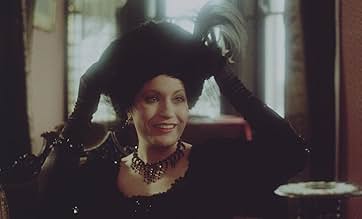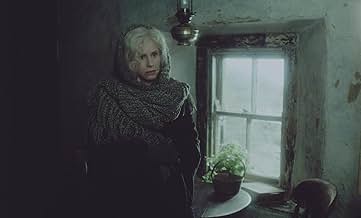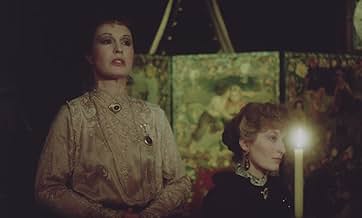Añade un argumento en tu idiomaA wealthy visitor to a small town befriends a midget and gets involved with two women as his behaviour becoming ever stranger.A wealthy visitor to a small town befriends a midget and gets involved with two women as his behaviour becoming ever stranger.A wealthy visitor to a small town befriends a midget and gets involved with two women as his behaviour becoming ever stranger.
- Dirección
- Guión
- Reparto principal
Vivien Heilbron
- Frederikke
- (as Vivian Heilbron)
Reseñas destacadas
of a wonderful book. Rutger Hauer is at his best. The only thing that puzzled me was the ending, I did not understand the need to change the original ending of the book, it just doesn't make sense.
This film is very rare to find, but not the book, so if you want to read a masterpiece, here's your chance.
This film is very rare to find, but not the book, so if you want to read a masterpiece, here's your chance.
Rutger Hauer was in so much crap during his Hollywood career that it's surprising to recall during his first decade of primarily Dutch features he seemed more in the vein of Daniel Day Lewis or Max von Sydow--a superb emerging international star who could do almost anything. Not that his acting declined later, but with occasional exceptions, his vehicles certainly did. This lesser-remembered English-language Dutch production, which apparently did not get a U.S. release at the time despite its cast names, finds Hauer ideally cast (in theory at least) as Knut Hamsun's perplexing antihero-an alternately virtuous, mad, maddening, self-contradictory and often compulsively lying visitor to a provincial town where his charismatic personality and curious actions quickly set everyone abuzz. (That they nonetheless more or less accept him socially seems mostly a testament to the fact that he appears to be rich.)
The townspeople never really figure him out, and neither does the reader--Hamsun leaves Johan Nagel duly a "mystery," his background and motivations murky even when we're privy to his own thoughts. The only sure thing one can say about him is that he is mercurial and seemingly unstable (Hamsun himself suggested the character "goes insane"), whether his various provocations are all deliberate or not.
The major change here is that instead of an ordinary Norwegian town, the film (shot on the Isle of Man) takes place in a more posh-looking seaside community. The film also has that gauzy, soft-focus look of 1970s movies set in "the past," though it's hard to fully appreciate its no doubt handsome production values in the old VHS transfers that are currently the best you can find online.
Because this is the 70s and "Emmanuelle" star Kristal is involved, there is some nudity, which almost certainly would have shocked the bejesus out of Hamsun. The erotic elements shoehorned in really never mesh with the whole, and needless to say are completely at odds with the book's content. Kristal is rather dull in this part, anyway, and actually not that flattered by her look here, which is unfortunate because in the book the whole point of the character is that she's unremarkable save for the extraordinary beauty that has turned the head of every man around. (A student has already possibly committed suicide for unrequited love of her at the story's start.) Both hers and Hauer's performances are somewhat compromised by presumably being dubbed by British actors. Rita Tushingham is a bit miscast as the poor older woman the protagonist takes also takes an interest in, though David Rappaport is good as the local "cripple" he likewise directs sometimes confused charitable instincts toward. Marina de Graaf, who started her career out playing nymphet roles, naturally gets stripped for another brief nude scene that seems to exist just so the movie might have a few stills it could use to sell itself as "Emmanuelle"-type softcore.
Most of what is in "Mysteries" is faithful enough to the book--well, apart from one jarring, unnecessary departure at the end. Yet it's extremely compressed, so the internal logic (or rather consistency of illogic) that Hamsun lends Nagel never crystallizes here. Instead, we simply get the feeling the filmmakers failed to communicate the story's gist or point. That's because they haven't conveyed that the primary narrative force is meant to be Nagel's oft-inexplicably changeable moods and actions. Hauer would certainly be up to illustrating those contradictions, but the movie doesn't really give him the time, scenes or depth. So it's an intriguing performance that can finally only hint at the complexities this "Mysteries" skims over. This is a watchable, well-produced movie, but one whose drastic condensation of a difficult, "psychological" (rather than plot-driven) literary text reduces that source material until its actual value is almost entirely lost.
The townspeople never really figure him out, and neither does the reader--Hamsun leaves Johan Nagel duly a "mystery," his background and motivations murky even when we're privy to his own thoughts. The only sure thing one can say about him is that he is mercurial and seemingly unstable (Hamsun himself suggested the character "goes insane"), whether his various provocations are all deliberate or not.
The major change here is that instead of an ordinary Norwegian town, the film (shot on the Isle of Man) takes place in a more posh-looking seaside community. The film also has that gauzy, soft-focus look of 1970s movies set in "the past," though it's hard to fully appreciate its no doubt handsome production values in the old VHS transfers that are currently the best you can find online.
Because this is the 70s and "Emmanuelle" star Kristal is involved, there is some nudity, which almost certainly would have shocked the bejesus out of Hamsun. The erotic elements shoehorned in really never mesh with the whole, and needless to say are completely at odds with the book's content. Kristal is rather dull in this part, anyway, and actually not that flattered by her look here, which is unfortunate because in the book the whole point of the character is that she's unremarkable save for the extraordinary beauty that has turned the head of every man around. (A student has already possibly committed suicide for unrequited love of her at the story's start.) Both hers and Hauer's performances are somewhat compromised by presumably being dubbed by British actors. Rita Tushingham is a bit miscast as the poor older woman the protagonist takes also takes an interest in, though David Rappaport is good as the local "cripple" he likewise directs sometimes confused charitable instincts toward. Marina de Graaf, who started her career out playing nymphet roles, naturally gets stripped for another brief nude scene that seems to exist just so the movie might have a few stills it could use to sell itself as "Emmanuelle"-type softcore.
Most of what is in "Mysteries" is faithful enough to the book--well, apart from one jarring, unnecessary departure at the end. Yet it's extremely compressed, so the internal logic (or rather consistency of illogic) that Hamsun lends Nagel never crystallizes here. Instead, we simply get the feeling the filmmakers failed to communicate the story's gist or point. That's because they haven't conveyed that the primary narrative force is meant to be Nagel's oft-inexplicably changeable moods and actions. Hauer would certainly be up to illustrating those contradictions, but the movie doesn't really give him the time, scenes or depth. So it's an intriguing performance that can finally only hint at the complexities this "Mysteries" skims over. This is a watchable, well-produced movie, but one whose drastic condensation of a difficult, "psychological" (rather than plot-driven) literary text reduces that source material until its actual value is almost entirely lost.
Although this is a good adaptation of Hamsun's most well know novel,a more realistic,if somewhat depressing, film called "Hunger" that was made in Norway in 1966 captures the feel of his work even better. This film by Henning Carlson is difficult to find but worth seeing out. It depicts Hamsun's struggle as an aspiring artist to survive in Christianna,now Oslo, where he faces starvation. Per Oscarsson and Gunnel Lindblom(from Ingmar Bergman's films) are the lead actors and do a terrific job of portraying the lead characters. I don't know if it is available in VHS or DVD but "Mysteries" did come out in VHS format although,as yet, I have not seen it on DVD.
This is a fascinating little film. It is based on a Knut Hamsun novel. It stars Rutger Hauer as an enigmatic agronomist who finds himself in a small town near the ocean. It has a truly European flavor. He is long on ambition and very lonely. He becomes a puzzle to the people in the town, despised by some. He befriends a midget, whom the locals actually call "Midget." He falls in love with a vain woman who rejects him and manipulates. He falls back on an older woman who lives in a hovel on the side of a hill. He seems desperate, but he is so darned weird and so full of mysteries that no one can really figure him out. He is obviously despairing of a previous life and can't seem to move ahead. He is very strong and self centered in some respects; yet, he is fragile and self destructive in others. The midget is his true friend and we find out that he has great sympathy for his plight (he is ill treated daily by the villagers), yet we find him, at times, almost as cruel as the townspeople. He becomes angry at the midget because he doesn't stand up for himself, yet he is totally closed up himself. The strength and the weakness of the film is our lack of concrete connection to the man. He is likable at times and so irrational at others. It's a film well worth watching. It was filmed on the Isle of Mann which adds to its mysterious nature.
In MYSTERIES, agronomist, Johan Nagel (Rutger Hauer) arrives in a small, seaside town where he befriends a small man (David Rappaport), whom the townsfolk seem hellbent on humiliating and otherwise tormenting, until Nagel intervenes.
Nagel spends much of his spare time walking around in the world's largest fur coat. He also enjoys checking out the local female population.
A bit of an enigma, Nagel is kind one minute, and biting someone, or poisoning their dog the next!
This is a stunningly slow movie. While many films of its era are rather slow moving, this one appears to subvert time itself, actually running backward in many spots!
Hauer isn't really the problem, and he somehow keeps his dignity intact throughout this interminable affair. His character is fairly interesting in a bizarre, looney sort of way. However, anyone expecting a true story line, action, or even a pulse from this movie had better steer clear!
Punctuated by Rappaport's voice-over narration and sudden, inexplicable nudity, MYSTERIES has no real reason to exist, other than to offer Hauer an excuse to stroll about in his grizzly bear coat...
Nagel spends much of his spare time walking around in the world's largest fur coat. He also enjoys checking out the local female population.
A bit of an enigma, Nagel is kind one minute, and biting someone, or poisoning their dog the next!
This is a stunningly slow movie. While many films of its era are rather slow moving, this one appears to subvert time itself, actually running backward in many spots!
Hauer isn't really the problem, and he somehow keeps his dignity intact throughout this interminable affair. His character is fairly interesting in a bizarre, looney sort of way. However, anyone expecting a true story line, action, or even a pulse from this movie had better steer clear!
Punctuated by Rappaport's voice-over narration and sudden, inexplicable nudity, MYSTERIES has no real reason to exist, other than to offer Hauer an excuse to stroll about in his grizzly bear coat...
¿Sabías que...?
- CuriosidadesRutger Hauer learned to play the violin for this movie.
Selecciones populares
Inicia sesión para calificar y añadir a tu lista para recibir recomendaciones personalizadas
- How long is Mysteries?Con tecnología de Alexa
Detalles
Contribuir a esta página
Sugerir un cambio o añadir el contenido que falta

Principal laguna de datos
By what name was Misterios (1978) officially released in India in English?
Responde





























